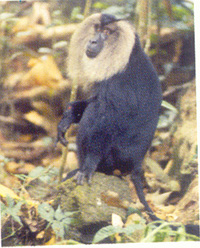Adventure
 'I believe any trip in search of wildlife can be coupled with physical activity and elements of cultural diversity to form a thrilling opportunity ' 'I believe any trip in search of wildlife can be coupled with physical activity and elements of cultural diversity to form a thrilling opportunity '
John H.Eickert
I had been walking a short while and there in a tree, just in front and above was a large dark creature licking the leaves from the tree it was sitting in. Such was my first encounter with the lion-tail macaque. I
was in Silent National Park walking the step shaped foothills of Kerala. Silent is in Kerala above the community of Perintalmanna or south from Ooty in Tamil Nadu in the Western Ghats. It is a very small park, part of a larger area. Most of the parks and some
of the land here belongs to an experimental area called the Nilgiri Biosphere Reserve.
What is unique is the desire to preserve the land and wildlife, and a way of life as well. Here indigenous subsistence living is encouraged and hopefully sustained. Indeed, the last hunter-gatherer group on the peninsula,
the Cholanaickens, lives here. With large corporate greed swirling unchecked and out of control across the face of our planet, I wish those people well and wish them much luck.
I also hope the Nilgiri Biosphere Reserve finds success, showing respect for the land, the wildlife, and the people who live there is an experiment contrary to life on our planet. I think it is a giant step forward.
In the tree, I think it was a fig tree, sat the dog sized black macaque with light colored facial hair and not surprisingly a long tail with a tuft of fur at the end, a lion tail! The tree was very tall, perhaps 50-55 meters. We were in a small dark forest
surrounded by grassland. Such forests in the Western Ghats are called sholas.  These sholas have always existed, but were enhanced by timber felling and fire from the hand of man. In our age, I can imagine this taking place, but timber-felling tens of thousands
of years ago could not have been that easy. These sholas have always existed, but were enhanced by timber felling and fire from the hand of man. In our age, I can imagine this taking place, but timber-felling tens of thousands
of years ago could not have been that easy.
I heard an answer to this riddle actually I heard it twice. I was told that it is possible, if properly trained, to shout down a large tree. Really, shouting in the Silent Valley! I have no reason to doubt what is
possible, as I have witnessed so many things, which I probably would not have believed had I stayed home. During my walk in the forest I also saw a giant Indian pied hornbill wing across a stretch of grassland and watched a Malabar squirrel hustle along the
branch of a tree. This area of India is rich in wildlife including tigers and elephants. The Western Ghats region is a wet forest, but not a rainforest. In a rainforest, there is precipitation year round, while in the Western Ghats and Silent Valley the rain
is seasonally heavy. It rains enough to sustain the forest and its creatures during the drier periods. I long for more time in these rich forests and I hope to see you there.
Please, take the time to go and when you go take your time.
Cheers.
(Photograph of lion tailed macaque by Ajith Kumar, ENVIS)
P.S by Dr. Susan Sharma
You can check the location of Nilgiri by clicking on the link below.NILGIRI BIOSPHERE RESERVE
Visit
http://www.numbum.net or call NumBum Adventurers at 406-777-2228
|
Answers To Quiz Of The Month
This month no one has given all right answers. echveeiyer@hotmail.com has given 9 right answers.
Right Answer toQuiz on rainforests
|
| 1.Which of the following does not contribute to rainforest loss worldwide |
|
pharmaceutical research |
urbanization |
agricultural growth
|
|
| 2.Nearly -----------% of the medicinal compounds we use everyday come from plants endemic to the tropical forest |
|
| 3.Circling the earth`s equator like a belt, the tropical rainforests maintain a constant temperature of 20 degree centigrade and receive anywhere from -------inches of rain per year |
|
| 4.A typical four-mile square mile patch of rainforest contains as many as ------species of flowering plants. |
|
| 5.A typical four-mile square mile patch of rainforest contains as a many as ------species of birds |
|
| 6.A typical four-mile square mile patch of rainforest contains as a many as ------species of mammals |
|
| 7.In the rainforest, most nutrients (over 75%) are contained in the |
|
| 8.In which country would you not find a region of tropical rainforest climate |
|
Bangladesh |
Indonesia |
Pakistan
|
|
| 9.------is an agile predator from the tropical forests of Asia, which normally hunts in the treetops |
|
clouded leopard |
spider monkey |
jaguar
|
|
| 10.The most abundant of rain forest insects are, |
|
Please try our quiz for the current month on
history of National Parks of India
|
Burning Issues
Vidya Athreya
 Junnar Forest Division is an anomalous name for a region almost completely devoid of any natural forests. The 4360 square km area is a predominantly agro based rural Indian setting with farm lands, houses, people living 176 to
a square km, domestic animals and their usual complement of feral dogs and cattle. Strangely in 2001 there appeared to be leopards too and not a few but more than 100 successful trappings were carried out between 2001 and 2003. This was in response to leopard
attacks on about 50 people. Junnar Forest Division is an anomalous name for a region almost completely devoid of any natural forests. The 4360 square km area is a predominantly agro based rural Indian setting with farm lands, houses, people living 176 to
a square km, domestic animals and their usual complement of feral dogs and cattle. Strangely in 2001 there appeared to be leopards too and not a few but more than 100 successful trappings were carried out between 2001 and 2003. This was in response to leopard
attacks on about 50 people.
Our study looked into the two main reasons cited for the escalating conflict. 1. increase in the extent of sugarcane (which was thought to provide an “ideal” habitat for the leopards in the face of destruction of their natural habitat)
2. decrease in wild prey base. Our analysis of satellite imagery of the entire Junnar Forest Divison across the last three decades, along with interviews with the affected people shows that that sugarcane was not the “causative” factor leading to the rise
in conflict. Also, rapid prey assessment carried out finds domestic animals to be most numerous. Information from satellite imagery as well as agriculture department records on land use patterns indicates that landscape level changes, especially related to
extent of forest and cultivated land has remained similar across four decades and is unlikely to have affected prey base levels so drastically.
What affected the conflict levels then? We found that in Junnar as well as in other parts of India, the most common strategy used by managers when dealing with leopards in conflict situations (be it they have fallen into wells, or
they are unwanted by the local people or there has been an attack, accidental or deliberate) is to trap them and then trans-locate them to any nearest patch of forest. This used to be carried out in western countries too in the 1980's until they realized that
it does not help and in many cases even trans-locates the problem to the new site of release. Moreover, in India, sites of release which support good forests, are few and it is likely that sustained releases of leopards at these few sites have and will lead
to increased leopard populations in the nearest suitable habitat be it tea plantations, sugarcane or millet fields.
We also found that some trans located animals, identified by the microchips we had inserted, actually moved conflict to sites where man – leopard conflict was never reported in the living memory of the people. We are now trying our
best to convince managers, policy makers and conservationists that it is very important to pay heed to scientific inputs when making policy decisions. This is especially true in the case of leopards, which as a species is very capable of living at the fringe
of human habitation and will soon be regarded as a pest rather than a beautiful large felid that needs to be conserved. The cases of poaching of leopards for their skin and body parts far out number that of tigers and it is likely that this species will soon
require better protection for which there has to be a public will. Considering the bad reputation it is increasingly obtaining now because of faulty policies, we may fast lose out on that chance.
|
Gardening for wildlife
|
 Ms.Promila Chaturvedi is a freelance landscape designer whose organization "Gardens India" undertakes a number of projects in landscaping and gardening. Ms.Promila Chaturvedi is a freelance landscape designer whose organization "Gardens India" undertakes a number of projects in landscaping and gardening.
|
In big towns, where the pressure on land is so high that the houses are very close to each other, one finds it difficult to live without encroaching the privacy of neighbours. One can combat this problem by giving a simple twist in the planting scheme.
One can add a few charming climbers on a steel frame (trellis) in the direction which needs hiding. If some body wants to add colour to a drab wall the climbers can be trained on it. One of these climbers is Ipomoea, which is not only easy to grow but also
very colourful
Ipomoea belongs to a large Clnvolvolaceae family. Ipomoea is a combination of two Greek words Ipso-means bind and nomios means similar. It is found in tropical and sub tropical region of the world. Approximately four hundred varieties of
Ipomoea are introduced in India. They are hardy, self-supporting, evergreen and vigorous climbers shrubs and ground covers and some of them are annuals also. They grow 1.8m to 13m in height. The funnel shaped flowers are large and showy, but short-lived.
These are not fussy plants. They can be grown in acidic as well as alkaline soil. But too much of acidic or alkaline soil does not suit them. They do not like water logging.
Some of the ipomoeas have economic value also. Ipomoea batata- the sweet potato is grown for its food value. A purgative is taken out from Ipomoea turpenthum. In Britain resin from Ipomoea perga is used as purgative. Ipomoea pescaprae is a sand binder.
Ipomoea palmata
 It is woody perennial with large flower, which blooms August-October, in purple blue, and rich-green palmate leaves it is also known asRailway Creeper. It is from South America but now grows in hot parts of both hemispheres. It
can screen a very high structure and give full privacy to the residents living in multi-storied society flats. It is woody perennial with large flower, which blooms August-October, in purple blue, and rich-green palmate leaves it is also known asRailway Creeper. It is from South America but now grows in hot parts of both hemispheres. It
can screen a very high structure and give full privacy to the residents living in multi-storied society flats.
Ipomoea bonanox
It is a night flowering Ipomoea, which is known as Chandra Kanti. It is a very fast growing flower creeper. Its flower starts opening at sunset, and the flower has a lovely perfume.
Ipomoea horsfalliae -Crimson Ipomoea
The large structure is ovate-palmate with five leaves. Though evergreen but unlike most perennial Ipomoeas it does not bloom round the year, it flowers from September-December only. Its flowers are narrow 2.6in; funnel shaped and deep rose in colour.
It is found in hot parts of American region and old world and cultivated all over in tropic and sub-tropical region. It is difficult to grow.
Its flowers look very charming on trellis or on veranda or tree trunk.
Ipomoea purpuria
The common morning glory is an annual hairy climber with ovate-acuminate leaves. Flowers are 2-3in long funnel shaped, pale blue to purple in colour grow five in a bunch usually.
Ipomoea rubrocaerulea or Nipomo Tricolour
 Rubrocaerulea means red and sky blue. It is bluer than red and rather smaller than other blue ipomoeas and having a feel of red veins and the throat is white. It is an annual and native of Mexico but now is grown almost in all hot countries. Rubrocaerulea means red and sky blue. It is bluer than red and rather smaller than other blue ipomoeas and having a feel of red veins and the throat is white. It is an annual and native of Mexico but now is grown almost in all hot countries.
Its new hybrids are-. `Wedding Bells', Tricolour `Flying Saucers' have white flowers flaked blue.
The annual Ipomoeas or Morning glory's seed have hard shells; so before sowing chit and soak overnight.
|
News and Views
News….
This month we are announcing the launch of "Wildscapes.net".
Wildscapes is a subset of our online club
Indianwildlifeclub.com .
Wildscapes.netis an online gallery of nature and wildlife photographs by committed photographers from India . These photographers have been showcasing their work at "Wildscapes"
the annual photo exhibition organized by IndianWildlifeClub.com at India Habitat Centre, New Delhi . New photographs / photographers are being added on a continuous basis.
Prints of the photographs, in various sizes, can be mailed to you for a small fee. We have also made provision for high-resolution images to be mailed to you in a CD / to be downloaded from a password protected site.
The images are searchable by key words. You can also search on multiple key words (advanced search). A list of key words is available to you. Simply mark the images you are interested in and add them to your light box (this will be retained
for 7 days should you wish to return to it). Then place your inquiry/order and complete the required details for online purchase through a secure payment gateway.
The soft launch of the site was done in May 2004 by Mr. D.P.S Sandhoo, Chief Public Relations Officer, Northern Railways, who took time off to visit the exhibition and also declare open the online portal "Wildscapes.net"

Views………..
" I have just returned from Himachal and was again astonished by the perfection of nature. Right along side the Beas river, a hot spring bubbled up from the ground and there were people bathing in that hot water. If you hike in the Himalayas , you'll see deep
cavernous caves that are cool in summer and warm in winter. They always contain small ash patches where some wandering shepherds took shelter and cooked food. And if you sit on a terraced hillside, the earth against your back will be perfectly contoured with
your body. And there are miles and miles of space with distant mountains and a blue sky with soaring eagles.
I am mentioning the wonders of nature because Vaastu Shastra itself believes that our homes should have the perfection of the human body, which is a marvel of nature itself. If Vaastu was only about North, South, East and West, it wouldn't
have survived for 4000 years. It survived because it saw the link between a human being, his house, and nature. It saw that a house was necessary to protect us from the extremes of nature, like storms, lightning, cold winds, and torrential rains. But it also
saw a danger of homes becoming fortress-like in the centuries to come. Which is why it emphasized the five elements of nature which Vaastu seeks to harness for human welfare. These elements are earth, wind, water, fire and space. And Vaastu stoked our awareness
of these elements by attributing directions to each.
So wind became represented by the North-West, water by the North -East, fire by the South-East and Earth by the South-West. Our wise ancestors engaged themselves in great introspection. By attributing four natural elements to four directions,
they hoped we'd build houses that would let nature in and not shut it out. ……….."
Jugal Kishor " A Window to nature", Times of India September 19, 2004
|
Zoo
 |
Toby Ninan retired from Delhi Zoo about two years back. With his varied experiences with the wild animals in the zoo, he is the right person
to direct your queries to. Hear what Ninan has to say about his life and chosen career! |
I had always (before this incident) wanted to know about he minimum space through which a leopard could escape as this was something which was a sort of a night mare which I had always dreaded. Mind you the time was before tranquilizers
came into the arsenal of the Zoo.
Well I learnt it the hard way as I did most of my difficult lessons in wild life management.
My old father with the help of a cousin sister had arranged my marriage and finally I brought my bride home. No sooner had I brought her across the threshold of the house, the door bell was ringing stridently which as all zoo people
know spells trouble. This time it was trouble spelt with capital letters.
The black panther which was confined to the hospital and in the squeeze cage had escaped and was roaming around the big hall which served as a hospital ward. Luckily one side of the entrance to the hall had a set of double doors and
the other exit had a single door. All these were closed so the animal could not escape into the outdoors and become a real menace. The hall had ventilators about four on each side and high up where no animal could climb up to.
 There were not very many options and with a fervent prayer in my heart, the carpenter, myself and other staff got to work. The side which had double doors and a space in between was our hope for getting the animal out. There was
one set of doors which opened - he other set of doors which were of also of wood had to have an opening cut out in such a way that only when we wanted would the opening be seen, till then it would just be four thin saw cuts in all four sides of this opening
–ie.two vertical and two horizontal- the traveling crate was put flush against this opening and after a final push the opening was visible- till this time the four cuts that formed the incipient opening just held on by mere slivers of wood. There were not very many options and with a fervent prayer in my heart, the carpenter, myself and other staff got to work. The side which had double doors and a space in between was our hope for getting the animal out. There was
one set of doors which opened - he other set of doors which were of also of wood had to have an opening cut out in such a way that only when we wanted would the opening be seen, till then it would just be four thin saw cuts in all four sides of this opening
–ie.two vertical and two horizontal- the traveling crate was put flush against this opening and after a final push the opening was visible- till this time the four cuts that formed the incipient opening just held on by mere slivers of wood.
Now that the up-slide was in position and the opening in the door was with out any impediment. We could also shoo the panther into the crate but how! This is where a bright idea ie. Diwali crackers came into the picture. We had about
eight men clamber up to the ventilators on either side of the outer side of the hall and throw lighted crackers into this ward of the hospital. Again to our good fortune there were no other patient in this hall –it would have been disastrous if there were
some excitable deer or birds there,who in turn would have committed suicide by crashing into the sides of their crates in the face of this barrage of bursting crackers! To shorten a long story –about four hours later the panther could not stand this onslaught
of noise and rushed into the traveling crate and was safely shut in it.
The wound for which the panther was hospitalized had any way nearly healed and we decided to continue dressings in its enclosure.
We could finally go in to the hall and inspect the squeeze cage and to our dismay we found one of the bars had broken of from the bottom and was bent to one side leaving a gap of 8” through which the animal had escaped. Thus I had the
answer to my question! How the bar broke or was bent is a mystery which was never solved .!
|